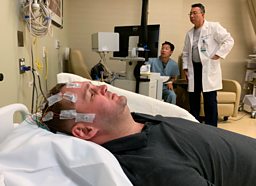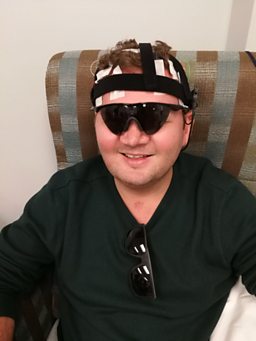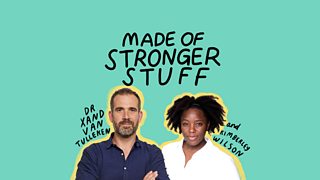How a brain implant helped a man see his wife again
In ΒιΆΉΤΌΕΔ Radio 4's Made of Stronger Stuff, psychologist Kimberley Wilson and Dr Xand van Tulleken ask what the human body has to teach us about the world around us.
In episode one, "The Eyes", writes Emily Finch, Xand and Kimberley explore the surprising gap between what we see and what we perceive. They learn how a brain implant allowed one man to "see" again.
The Crash
When Jason Esterhuizen’s car flipped over and he was thrown on to the road, his world went black. Jason was just 23 years old and on track to becoming a commercial airline pilot in his native South Africa. His life had been going the way he had planned and he was happy.
βI woke up from being able to fly an aeroplane to absolutely seeing nothing"
But all that changed on 13 December 2011. Jason was driving with two of his friends when he had to brake hard to avoid a pedestrian. He lost control of the car and launched out of the sunroof, sustaining severe facial injuries including broken eye sockets and a broken skull. He was not wearing a seat belt. His two passengers survived and their injuries weren’t as severe as Jason’s who had to be put in an induced coma for 23 days.
“I woke up from being able to fly an aeroplane to absolutely seeing nothing,” recalls Jason. Doctors told him he was now blind and there was nothing they could do to restore his eyesight. Jason remembers how it felt: “It was pretty scary to start living in the darkness.”

The TV Show
Jason spent the next few years in recovery. First, he had to have a series of reconstructive surgeries on his face. He then attended a school for the blind in the Western Cape, a province of South Africa, where he learned Braille. But he was always searching for a new piece of tech or medical innovation that might go some way towards restoring his vision.
A popular investigative journalism TV show in South Africa featured a new retinal implant which could restore some sight in blind people with retinitis pigmentosa, a genetic disorder of the eye. Second Sight, the American company behind the device, was now working on a brain implant that could help Jason in his quest to see again. Jason remembers being inundated with text messages from his friends who had watched the show: “Everyone was telling me, Jason, you have check this out. It's so cool. So, yeah, I had a lot of people behind me backing me and, you know, rooting for me.”
Before he had a chance to email Second Sight, a friend had already reached out to them requesting a place for Jason on the trial. The device was called the Orion II, named after one of the brightest constellations in the night sky. Jason felt he didn’t have anything to lose by taking part in the trial: “I can't get any blinder than I am.”
The Answer is Light
Jason and his wife Sue travelled to Los Angeles where Jason underwent a barrage of medical tests, after which he was told he was eligible for the implant. They both burst into tears at the news, hopeful that Jason would regain some sight. But before that, the Orion II would need to be surgically inserted into his brain at the UCLA medical centre.
The device has multiple parts including a processing unit which encodes images picked up by a video camera within a pair of sunglasses worn by Jason. The unit then wirelessly transmits the data to the implant in Jason’s brain which stimulates the visual cortex, a part of the brain which processes visual information. The patterns stimulated in the visual cortex change with the images captured by the video camera.
Two weeks after the operation, Jason’s medical team stimulated his new brain implant for the first time. He remembers what he saw: “Boom, all of a sudden, I saw one little white dot and it blew my mind. I still don’t have words.”
We all see these dots and flashes, better known as phosphenes, when we apply pressure to our eyes when our eyelids are closed. Our brains can create the perception of light through stimulation. Jason’s device was configured so he would see more flashes when he was looking at bright colours or sunlight.
The device has helped Jason to cross busy roads, sort his laundry and find his wife when she gets angry with him and stays silent. He says his vision is now similar to looking up at the stars at night.
So what has this meant for Jason? He has used his renewed sight to create a new perspective for himself: “Losing your eyesight can open you up to what the world actually has to offer.”

You can listen to Made of Stronger Stuff from 27 January. Subscribe now on ΒιΆΉΤΌΕΔ Sounds.
We think you'll also like...
-
![]()
All in the Mind: Our visual experience
How do you see colours? Do you like to make eye contact with others when you're in conversation. Claudia Hammond and guests explore the complexity of our visual experience.
-
![]()
A Good Read: Chris and Xand Van Tulleken
Doctor twins Chris and Xand van Tulleken talk to Harriett Gilbert about favourite books, recommending The House of God by Samuel Shem and a poetry collection by James Fenton.
-
![]()
Digital Planet: Brain implant regulation calls
Brain implant regulation calls. Also biometric legislation where are we now? Brazilian privatisation and data use and a new type of low energy computer memory.
-
![]()
Food and Mood: how eating affects your mental health
We instinctively know that what you eat can boost your mood, but now the science is showing the true extent to which diet impacts depression and anxiety.





